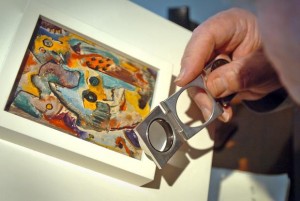 By Mike Mosser, Consumer Insurance Guide
By Mike Mosser, Consumer Insurance Guide
Whether it’s a box of old coins, an authentic Picasso or an heirloom just waiting for an “Antiques Roadshow” moment, keeping track of and insuring one’s valuables is something that’s easy to overlook. A homeowner’s insurance policy may not fully cover everything in the home and their records might not be complete.
Salvador Dali was one of the most popular and prolific surrealists of the 1900s, which is probably why his name is often used by forgers trying to make a buck. This has resulted in lawsuits over alleged fakes and conflicting opinions among self-titled Dali experts.
For anyone considering a “Dali” purchase, it’s a good idea to do some research beforehand and check whatever authentication or appraisal information the dealer provides and to make sure it’s from a reputable and independent source.
Towards that end, there are two useful resources for any Dali enthusiast.
The Salvador Dali Archives. A project begun by respected Dali expert Albert Field, who was chosen by Dali to catalog the artist’s work. The archive publishes The Official Catalog of the Graphic Works of Salvador Dali and performs authentication services. click here.
The Gala-Salvador Dali Foundation was created by Dali to protect the artist’s legacy. It operates four Dali museums, publishes a catalog raisonne and performs authentication services. click here.
Just as the concept of art varies among people, so does the notion of what needs to be insured. Alan Bamberger, an art consultant, appraiser and author of “The Art of Buying Art” notes that a $1,000 loss to one person might be a greater impact than a $10,000 loss to someone else.
“They need to start thinking about it whenever they feel that the art is valuable enough to be included on the insurance policy. It’s a different number for different people,” Bamberger says. “A lot of that is up to the collector, there’s no set rule. It’s like how you look at your own money, when do you want to start worrying about it? At some point it’s better to have it at least documented and itemized whether it’s insured or not, just for posterity purposes or for purposes of inheritance.”
 Someone with just a few collectible items might get by with a standard homeowner’s policy, although they need to be aware that in addition to having an overall insurable limit a policy will also have smaller restrictions on coverage within certain property classifications.
Someone with just a few collectible items might get by with a standard homeowner’s policy, although they need to be aware that in addition to having an overall insurable limit a policy will also have smaller restrictions on coverage within certain property classifications.
Checking coverage
Jan Weyhrich, inland marine program manager at State Farm Insurance, says a homeowner’s policy could have limits on collectibles such as art, jewelry and stamps, along with more ordinary items like Oriental rugs and tapestries.
For example, a policy might have a $200 limit on the loss of a coin collection or $2,500 for a gun collection. Weyhrich says anyone whose possessions exceed their policy’s limits may want to make sure they’re fully covered though a separate Personal Articles Policy.
“Under your contents coverage you might have, say $150,000 and that covers everything from soup to nuts, everything from the spoons to the dog dish. That has a specific limit of liability, all of that is grouped underneath it,” Weyhrich says. “The thing is with collectibles and then especially with jewelry, sometimes you can get into some coverage limitations. That’s where it’s a good idea to sit down and review the policy with your agent every year or every other year.”
Not only can a policy have limits that a homeowner might not be aware of, they could also have items that were more valuable than they think—such as an antique watch or a coin collection. Weyhrich said he knows of one customer who inherited a painting and never thought much about it until a friend suggested he get it appraised. It turned out to be worth $300,000.
“We insure a wide range of value when it comes to jewelry and fine arts. We have some items ensured for $200 or $300 as far as a piece of jewelry all the way up to close to $1 million,” Weyhrich says. “A personal articles policy, it covers a wide value range. It’s just not necessarily for all high-end fine art, but it could be for lower values as well.”
Weyhrich suggests even those whose possessions don’t need additional coverage should document what they own with pictures of special items and whatever records they have—and to keep that information at a separate location in case of a disaster. Jewelry and heat-sensitive documents could be kept in a fire and burglary-resistant safe.
Depending on the extent of a collection, a centrally monitored burglar alarm system would not only provide an additional layer of protection security but can also result in lower insurance premiums.
Bamberger says anyone with a substantial art collection should deal with someone who specializes in and understands the value of what they’ve acquired.
“You can have a rider on your policy, you can have a rider on your homeowner’s or whatever if it’s not a big deal but if you start getting serious then it’s best to have a specialist on your side insuring the collection.” Bamberger says. “You want whoever is insuring it to know something about it.”














